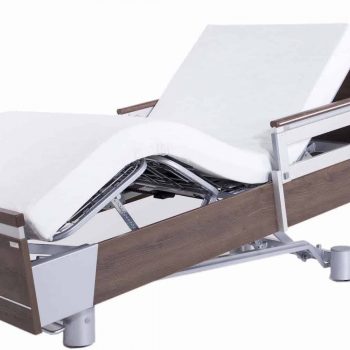

Hospital Beds
Adjustable Hospital Beds vs Electric Hospital Bed: What's The Difference?
SonderCare Learning Center

SonderCare Learning Center

Health & Medical Writer
Written & Researched

Hospital Bed Expert
Fact Checker & Commentary
When considering the purchase of a hospital bed for home care, the distinction between adjustable hospital beds and electric hospital beds is paramount. This article will delve into the key differences between these two types of beds, shedding light on their functionalities, comfort features, and technological advancements. Understanding the nuances will guide consumers in selecting the right SonderCare bed that best suits the needs of their loved ones or patients. Join us as we explore the advantages and considerations of these innovative sleep solutions designed for enhanced care at home.
SonderCare Editorial Policy
All of our articles are written by a professional medical writer and edited for accuracy by a hospital bed expert. SonderCare is a Hospital Bed company with locations across the U.S. and Canada. We distribute, install and service our certified home hospital beds across North America. Our staff is made up of several hospital bed experts that have worked in the medical equipment industry for more than 20 years. Read more about our company here.
When considering the purchase of a hospital bed for home care or medical facilities, it is vital to understand the differences between adjustable hospital beds and electric hospital beds. While both types of beds serve the primary function of aiding patients, the level of comfort, flexibility, and operational ease they offer can differ significantly. Adjustable beds are generally designed to allow changes in the incline of the head and foot sections, which can be especially helpful for patients who spend a lot of time in bed.
That said, an adjustable hospital bed can also refer to a bed set with the capability to adjust typically not just in incline, but also in height, which can be a crucial feature for caregivers. On the other hand, an electric hospital bed is a more comprehensive solution equipped with a motorized system to effortlessly change bed positions, often including the Trendelenburg position.
The convenience of an electric bed with remote controls makes it possible for patients to independently adjust their position, enhancing their autonomy and comfort. The versatility of electric hospital beds usually means that they come in various sizes, such as twin or full, to cater to the diverse needs and preferences of patients.
Price point can be a deciding factor for many, and here, it’s important to note that an adjustable hospital bed can have a price range that reflects its simpler mechanical functions compared to the advanced features of an electric hospital bed.
Additionally, the choice of mattress and other equipment complementing the bed can influence both the final cost and the effectiveness in patient care. As for the trends in patient care, there’s been an inclination towards beds that offer multiple adjustment options to ensure that the patient’s needs are met with the utmost precision.
The factor of adjustability is critical as it directly impacts patient recovery and comfort levels during their convalescence. Contemporary adjustable beds and electric hospital beds alike follow this trend, with a focus on patients’ specific requirements.
When deliberating between an adjustable hospital and an electric hospital bed, consider the patient’s needs, the ease of use, and the different features offered by each type. While an adjustable bed may present a cost-effective solution with manual adjustment capabilities, an electric hospital bed typically offers a wider array of positions and heightened convenience at a potentially higher price tag. Regardless of the choice, ensure that it aligns with the fundamental goal of maximizing patient care and comfort.
When considering the best option for patient care, especially within the confines of a home setting, it’s crucial to understand the distinct differences between adjustable hospital beds and electric hospital beds. Both types of beds offer unique benefits that cater to the varied needs of patients recovering or dealing with health challenges at home. The use of an adjustable bed can be seen as a versatile choice, not only in hospitals but also as a homecare bed. These beds typically have a range of motion that allows the head, feet, and sometimes the height of the bed to be manually adjusted to enhance patient comfort. Meanwhile, electric hospital beds feature motorized adjustments, offering the convenience of altering bed positions with the push of a button, which is ideal for patients and caregivers when ease and speed are necessary.
Both adjustable and electric hospital beds serve as pivotal pieces of equipment for those needing extra care. With the push of a button, an electric hospital bed can quickly transition to aid in therapy, provide support during incontinence care, or simply to help a patient reach a seated position with minimal discomfort. Moreover, electric beds are often used in conjunction with various care apparatus such as lifts and wheelchairs, facilitating a more efficient caregiver assistance process.
In the realm of home care, the choice between an adjustable bed or an electric hospital bed often depends on the level of care the patient requires. Electric hospital beds are typically seen as a more sophisticated option, equipped with features that can better support those with severe mobility challenges. For example, the ability of an electric bed to adjust swiftly can make a significant difference in emergency situations. On the other hand, an adjustable hospital bed might offer enough support and comfort for patients with moderate needs, becoming a cost-effective and still functional option for many families.
A major deciding factor is to consider the most appropriate therapy and support equipment for a loved one, it’s essential to consider their specific requirements. The key differences in use between an adjustable hospital bed and an electric hospital bed highlight the importance of customized care. While an electric hospital bed may provide unparalleled ease and support for both patient and caregiver, an adjustable hospital bed can offer ease of use, comfort, and flexibility. Whichever option you choose, ensure it aligns with the patient’s needs, as this will ultimately help in delivering the highest quality of care.
When deliberating the merits of hospital beds, particularly when comparing an adjustable bed to an electric hospital bed, size emerges as a pivotal factor. Standard hospital beds, including electric hospital beds, typically adhere to the twin size, which is suitable for most medical scenarios. However, as demand for personalized care grows, so does the variety in bed sizes. A key advantage of the adjustable hospital bed is its availability in larger sizes, such as full, which offers more space for comfort and ease of mobility. This added width can significantly enhance the recovery experience for users within home settings, where a homelike aesthetic is often desired.
The size of a hospital bed is not limited to its width but encompasses its length and height as well. Electric hospital beds typically present with a fixed height or a range that offers some adjustability to accommodate transfers and caregiving tasks. Conversely, high-quality adjustable hospital beds from brands like SonderCare extend beyond mere height adjustments—they can expand in length to suit taller individuals, thus ensuring a comfortable fit for a diverse user base.
Another pivotal distinction in size between an adjustable bed and a standard electric hospital bed lies in the options offered for height variation. For instance, beds from SonderCare are designed to reach a very low position to mitigate fall risks, which is particularly advantageous for those with mobility challenges. Moreover, the possibility to expand or contract a bed’s dimensions is a feature more commonly seen in adjustable hospital beds, ensuring a tailored fit for the individual’s needs and room size.
Choosing between electric or adjustable options should always consider the user’s unique requirements. For example, electric hospital beds are often sufficient for short-term use, yet if long-term care is anticipated, a larger and more versatile adjustable hospital bed may be the wiser investment. This holds true especially when considering the dimensions of the mattress, as the right fit is paramount for both comfort and therapeutic support. SonderCare understands this and offers a selection of beds that not only emphasize customization in size but also prioritize exceptional quality and innovation in their designs.
When assessing hospital beds to find the perfect match, remember that size does matter. Whether opting for a single, adjustable hospital, or traditional electric model, considering the dimensions and how they expand to meet the user’s unique needs can make a significant difference in overall satisfaction and comfort.
When considering the comfort and needs of a patient, understanding the differences between adjustable hospital beds and electric hospital beds, specifically in terms of inclinations, is key. Adjustable beds offer flexibility and can be fine-tuned to a variety of positions for the head and foot sections, providing tailored comfort for individuals recovering at home or in a healthcare setting. The ability to adjust these positions can aid in circulation and reduce pain and discomfort. On the other hand, a high-quality electric hospital bed often includes advanced features such as Trendelenburg or reverse Trendelenburg positions, which can be beneficial for certain medical conditions.
An electric hospital bed, equipped with a motorized lift, allows caregivers to easily adjust the height of the bed, a critical feature when providing patient care and reducing strain for the caregiver. The inclinations of an electric bed are designed to be adjusted effortlessly, often with the touch of a button, which can significantly increase a patient’s comfort. The assembly process for an electric bed tends to be more complex compared to that of an adjustable bed due to the additional electrical components, yet this complexity brings with it a greater range of positional adjustments and features.
On the contrary, adjustable hospital beds may offer manual options for changing inclinations, relying on the physical effort of a caregiver or the patient themselves. The adjustments may be less precise than those offered by an electric hospital bed, but they typically allow for the essential head and foot adjustments. An adjustable bed may also have a lower entry point in terms of cost, making it an appealing option for those with budget considerations while still providing a degree of comfort and positional variety.
In a comparative view, both types of hospital beds serve to enhance patient comfort and support healing through various reclining positions. However, an electric hospital bed has the advantage of delivering smooth, controlled movements for patient inclinations with minimal physical exertion needed from the caregiver. Regardless of whether one chooses an adjustable or an electric hospital bed, it is crucial that the chosen bed meets the specific needs and health requirements of the patient. Ultimately, the primary goal in selecting either an adjustable hospital bed or an electric hospital bed should be maximizing patient comfort, safety, and well-being.
When selecting a hospital bed, understanding the nuances between an adjustable bed and an electric hospital bed is critical, specifically when examining their hand controls. Hand controls are instrumental in delivering comfort and support to the patient, catering to their mobility and healthcare needs. Electric beds are renowned for their streamlined, user-friendly hand controls that foster a sense of autonomy for patients. These controls typically feature intuitive buttons that allow patients to independently adjust the bed’s position—reclining, elevating, and making minute adjustments to suit their comfort.
On the other hand, adjustable hospital beds may offer varying levels of control sophistication. Some come equipped with similar electric features that provide convenience and ease to the user, whereas others might have manual control options that require caregiver assistance. This distinction in hand controls could influence a patient’s choice depending on their personal needs and the level of independence they desire. For those who prioritize autonomy, modern electric hospital beds with seamless hand controls could make a world of difference in their daily comfort and quality of life.
As caregivers, we recognize that the ability to easily adjust one’s position can significantly impact patient well-being. Therefore, at SonderCare, we emphasize the importance of our clients being able to view and experience firsthand the benefits afforded by our premium electric beds. To help accommodate this need, we ensure that all orders from our shop reflect the latest innovations in patient support and comfort. When you choose an adjustable bed from SonderCare, you’re investing in state-of-the-art hand controls that are tailored to enhance the patient experience. If assistance is needed, we’re on hand to help guide your selection among various features and models.
The right choice between an adjustable hospital bed and an electric bed hinges on the unique requirements of the patient. The ease of hand control operations can make a significant difference in their standard of living. At SonderCare, we’re committed to delivering an unmatched level of service and expertise to simplify your decision-making process. Feel free to reach out to us, and let our specialized team support you in selecting the ideaal hospital bed. Empower your loved ones with the ultimate care solution that echoes SonderCare’s dedication to quality, comfort, and innovation.
| Feature | Adjustable Bed | Electric Hospital Bed |
|---|---|---|
| Hand Controls Purpose | Primarily focused on adjusting the position for comfort and convenience, such as head and foot elevation for reading or watching TV. | Designed to aid in both comfort and therapeutic needs, such as adjusting bed height for caregiving tasks and supporting specific medical conditions. |
| Hand Controls Complexity | Generally simpler, with basic functions for adjusting bed positions. | More complex, often with multiple buttons for various bed movements and patient positions. |
| Functions Available | Elevation of head and foot sections, sometimes with added features like massage or under-bed lighting. | Head and foot elevation, bed height adjustment, Trendelenburg positions, and sometimes lateral tilting functions. |
| User Interface | Hand controls are user-friendly and geared toward patient self-use. | Hand controls can be more complex, sometimes intended for caregiver use rather than the patient. |
| Adjustment Mechanism | May use a combination of electric and manual adjustment mechanisms. | Fully electric adjustments via the hand controls. |
| Control Placement | Controls are commonly located at the side of the bed or attached to the bed frame within easy reach of the user. | Controls can be mounted on the side rails or handsets that can be accessed by the patient or hung on the bed for caregiver access. |
| Inbuilt Safety Features | May include a lock-out feature to prevent unintended adjustments. | Often includes multiple safety features like lock-out, battery backup, and control disablement to prevent accidental movements. |
| Customization | Limited to preset positions for personal comfort. | More options for customization to cater to specific medical needs and patient care protocols. |
| Typical Use Case | Home use for individuals seeking enhanced comfort or minor support requirements. | Hospital or healthcare settings where patient support and caregiver assistance are paramount. |
When diving into the world of hospital beds, it’s essential to navigate the design distinctions between an adjustable hospital bed and an electric hospital bed. At the core, both aim to provide comfort and ease for the user, balancing the needs for medical efficacy and homecare practicality. With an adjustable bed, the design strikes a more universal appeal, often blending seamlessly into a home environment without the overtly clinical look that accompanies traditional medical equipment. An electric hospital bed, however, is geared towards patients with greater medical complexities, offering robust features that may include surgical-grade components and a design that can support extensive medical apparatus.
For those shopping for a bed, it’s vital to compare these options carefully. Electric hospital beds typically come with a design that allows the head and foot of the bed to be adjusted electrically, facilitating care for patients. In contrast, an adjustable hospital bed often permits manual adjustments, offering a less technical—but still highly functional—design. Mattress compatibility also varies; electric beds require mattresses that can conform to their movements, whereas adjustable beds might offer more leniency in mattress choices.
The design of an electric bed may include additional features such as built-in lifts, designed to assist patients in transitioning in and out of bed. These can correlate with other products such as lift chairs, providing a comprehensive care solution. Design-wise, every electric hospital bed and adjustable bed from a reputable brand, like SonderCare, is crafted with the user’s needs in mind, whether it’s helping a child or an adult. Complementing these beds, you may find accessories such as ramps or scooters, which are instrumental for patient mobility around the home.
For those interested in buying a bed, options are plenty. Starting your shopping experience by creating an account on a provider’s website can simplify the process, offering a streamlined buying guide that walks you through different bed features and design elements. Moreover, many providers offer free shipping, ensuring that your bed arrives without additional costs. This is especially pertinent for those considering a homecare bed; free shipping can significantly reduce total expenses. Always look for a bed with an appropriate bedside design that integrates well into the care setting, whether that’s hospital, hospice, or home. And don’t forget the importance of incontinence products, which can often be found in the same locations as beds, in the same shopping experience. Finally, remember that bed lift designs are becoming increasingly sophisticated, making it easier for caregivers to provide care without compromising their health.
In essence, whether you’re comparing adjustable beds versus electric hospital beds, the differences in design are intrinsic to the care and comfort provided. Be it for patients requiring minimal adjustments or extensive medical support, sound design in both electric and adjustable hospital beds is paramount in fostering healing and well-being.
Understanding the key differences between adjustable and electric hospital beds is paramount when making an informed decision. Adjustable beds provide basic functionality with manual adjustments, while electric hospital beds offer enhanced comfort and convenience with their motorized features. At SonderCare, we are dedicated to ensuring that each individual’s unique needs are met with high-quality and comfortable home medical solutions. Whether simplicity or advanced technology is what you seek, choosing the right bed can greatly improve the quality of life for those requiring care.

"SonderCare is the sole home hospital bed supplier I've discovered that effectively tackles senior health issues like mobility and falls, while concurrently taking into account the emotional well-being of patients and their families, and using a very dignified and welcoming design."

"SonderCare is the sole home hospital bed supplier I've discovered that effectively tackles senior health issues like mobility and falls, while concurrently taking into account the emotional well-being of patients and their families, and using a very dignified and welcoming design."
An adjustable hospital bed is a type of bed specifically designed for hospitalized patients or others in need of some form of health care. These beds have adjustable sections that allow for the elevation of the head, foot, or other body parts to various positions, aiding in patient comfort and care.
The primary difference lies in their operation. Adjustable hospital beds can be manual or semi-electric, requiring some physical effort or limited motor assistance to adjust. Electric hospital beds, on the other hand, are fully motorized and allow for effortless adjustment via remote control.
Generally, electric hospital beds are more expensive due to their advanced features, motorized components, and the additional convenience they offer. However, prices can vary based on the brand, features, and specific model.
Adjustable and electric hospital beds can be purchased from medical supply stores, online healthcare retailers, and sometimes directly from the manufacturers. Purchasing directly from the manufacturer such as with SonderCare is ideal because you get priority service, parts and extended warranty for your bed.
Start Exploring Hospital Beds With SonderCare
Are you recently discharged from hospital, experiencing mobility issues, or in need of palliative or senior care? Enjoy a smoother recovery and get the luxury you deserve by choosing our home hospital products. Contact us today to discuss home hospital beds, mattresses, stand assist chairs and other accessories to make your home hospice perfect for a truly comfortable experience.
Are you looking for the most recent articles on buying hospital beds? Browse our latest resources below and let us know if you have any questions. We’re here to support you as you embark on your road to home medical care.
Seeking The Best Care For Your Loved One?
Browse North America's Luxury
Adjustable Hospital Bed
Inventory